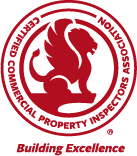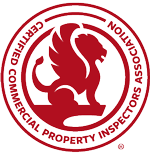Rusting describes the process of the corrosion of iron and its alloy, steel. CCPIA inspectors and commercial property owners should understand how rust forms and how to prevent it. Rust is more than a cosmetic issue; it can lead to serious structural deterioration.
Rust Formation
Rusting is a common form of corrosion – an electrochemical process leading to the disintegration of a material into its constituent atoms – a category that also includes galvanic corrosion, pitting corrosion, and crevice corrosion. Rust usually appears as a red, brown or orange flaking or pitting of the metal surface.
Rust is formed when oxygen comes into sustained contact with iron in a process called oxidation. Oxygen is delivered to the metal from water, either from liquid water or water vapor. Carbon dioxide in the air combines with water to form a weak carbonic acid, dissolving the water into its component parts – hydrogen and oxygen – as well as causing some of the iron to dissolve. The free oxygen bonds with the dissolved iron to form iron oxide or rust. Oxidation catalysts, such as saltwater and air, acids and acid rain, soils, and airborne sulfur compounds, will accelerate rust formation. Rust formation is also encouraged by architectural crevices that trap liquids. Once rust forms, its porous surface will trap additional liquids and lead to further corrosion.
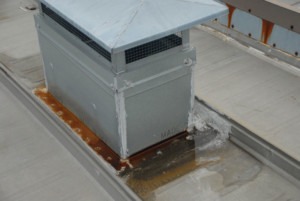
Identifying Metals that Can Rust
It may be helpful for inspectors and building owners to have some rudimentary knowledge about how to differentiate metals that can rust from metals that cannot rust. Iron and steel (including galvanized steel and stainless steel) are magnetic, while aluminum, copper, zinc, brass and silver are not magnetic. Tin is also magnetic, but its use in building construction is uncommon. Iron is typically dark in color. Galvanized steel has a dull appearance, while stainless steel is shiny and bright. Copper, which is commonly used in household wiring, has a bright, reddish color, although it can turn green when exposed to air. Aluminum, a building material commonly used in siding, is silver-colored and shiny. Professionals can perform further tests by exposing the metal to acids, or by measuring the size and color of the sparks produced when the metal is carved.
Other Facts and Figures
- The only metals that can rust are iron and alloys that contain iron, such as steel. Other metals may become corroded but they do not technically rust. For example, the corrosion of copper and its alloys, bronze, and brass, produces a green layer called patina or verdigris.
- Prime rust conditions occur when iron is regularly exposed to saltwater and humid air. Iron is relatively unaffected by non-saltwater or dry air.
- In 1998, rust caused an estimated $276 billion in damages, or 3.2% of the U.S. Gross National Product, according to the U.S. Federal Highway Administration.
- The neurotoxin that causes tetanus, a disease associated with rust, is the second most deadly known neurotoxin (after Botox®). One gram of tetanospasmin can kill 6,000,000 average-size men, making it approximately 1,600,000 times more potent than King Cobra venom.
The Connection between Tetanus and Rust
Tetanus is a potentially lethal medical condition characterized by muscle spasms, difficulty swallowing, and fever. Spores of the bacteria that cause tetanus – Clostridium tetani – lie waiting in ordinary soil, which can become easily trapped in the rough surface of rust. A dirty protruding nail or barbed wire serves as a vehicle for the bacteria to enter the body, where the spores within the dirt become activated by the lack of oxygen (as do all anaerobic bacteria) and quickly begin producing a potent neurotoxin called tetanospasm.
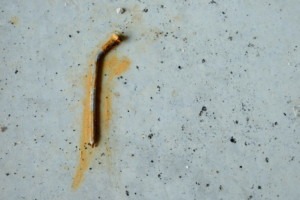
While rust is associated with tetanus, fears surrounding cuts from rusty metal are exaggerated for the following reasons:
- Tetanus is extremely rare, amounting to an incidence of 0.15 cases per 1,000,000 people in the U.S., according to the Centers for Disease Control. This rarity is largely accounted for by tetanus immunization shots. However, people who have not received recent vaccinations, such as older adults, are at increased risk for tetanus.
- The Clostridium tetani bacteria may be found on any objects exposed to soil, including metal objects that lack any rust. Even non-metal objects can transmit Clostridium tetani. A study of canine tetanus revealed that a large number of cases originated from cuts caused by sharp spikelets of grass known as foxtails. Any cuts caused by an object made dirty by soil, regardless of whether it is rusted or even metal, should be treated as a potential source of Clostridium tetani.
Rust in Buildings
Rust has considerably less mechanical strength than its originating metal and it will not adhere but will gradually flake off, weakening the structure. It also has a greater volume than iron, and its buildup will force apart adjacent parts, a phenomenon called “rust-smacking.” Through this process, rust can make a structure more vulnerable to collapse from weather, impact, or even gravity. The Kinzua Bridge in Pennsylvania collapsed in 2003 due to rust smacking when its central base bolts, which held the structure to the ground, simply rusted away.
CCPIA inspectors should be on the lookout for rust damage in the following locations:
- concrete-encased steel. Concrete is used to protect reinforcing steel bars from environmental moisture, but the metal will rust where mechanical damage has removed a small piece of concrete and exposed the underlying rebar. Even where the concrete is intact, moisture can penetrate concrete through microscopic stress fractures. As the iron turns to rust, the expanding volume forces the adjacent layer of concrete to fall away, which exposes more metal to moisture, rusting and destructive expansion. If this situation is not detected and remedied, the deterioration will persist and cause serious structural problems. Manufacturing defects that increase the likelihood of moisture penetration include insufficient cover (less than 1-1/2 inches of concrete), insufficient air bubbles to trap moisture, cement that was mixed with too much water, and inadequate time allowed for the concrete to cure before loads were applied;
- water pipes. Tap water that is brown, red, orange or yellow indicates rusted water pipes,
 especially older, unlined cast-iron pipes. While rusty water itself is not a serious health hazard, rusting water pipes may eventually leak and cause structural damage. The corrosion may be occurring within the building’s plumbing system (indicated by discoloration of hot water, discoloration at only one or several faucets, or if the water clears after it has run for several minutes), or at the water main (indicated by discoloration of the cold water, discoloration at all of the water faucets, or if the water does not clear after it has run for several minutes). Further assessment should be conducted by a qualified plumber;
especially older, unlined cast-iron pipes. While rusty water itself is not a serious health hazard, rusting water pipes may eventually leak and cause structural damage. The corrosion may be occurring within the building’s plumbing system (indicated by discoloration of hot water, discoloration at only one or several faucets, or if the water clears after it has run for several minutes), or at the water main (indicated by discoloration of the cold water, discoloration at all of the water faucets, or if the water does not clear after it has run for several minutes). Further assessment should be conducted by a qualified plumber; - roofs. Roofs are exposed to snow and rain, and unprotected roofs that are made from steel are prone to rust. The rust should be scraped off before paint or a rust-resistant sealant is applied. Many rust-damaged metal roofs have been painted over without repair, leading to moisture intrusion into the house. This type of defect may only be detected through the use of an infrared camera, which is why prospective buyers should hire an Infrared-Certified® InterNACHI or CCPIA inspector. Rust stains can also be found on non-metal roofs where rainwater has washed rust from metal roof components, such as chimneys, flashing and antenna mounts. Inspect these
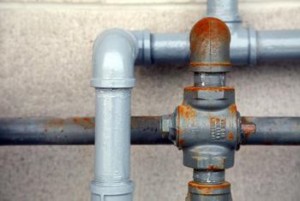 items for rust damage. If the stain is, in fact, rust, and not algae, mold, moss or soot from the chimney, inspect nearby metal components for rust damage;
items for rust damage. If the stain is, in fact, rust, and not algae, mold, moss or soot from the chimney, inspect nearby metal components for rust damage; - chimneys. Decaying leaves and pine needles create an acidic solution that will eat away at the galvanized coating on metal chimney covers, leaving them exposed to rusting from rain and melting ice and snow. The weakened metal will permit the entry of water inside the chimney, causing further rusting. This condition is less common in newer stainless steel chimneys, which are better suited for rust prevention, as well as chimney covers that slope in a way that prevents water from pooling. Observe the rusted chimney pictured at right, courtesy of InterNACHI member John Gromkoski;
- fuel oil tanks. Most fuel oil tanks are made from steel and are thus vulnerable to rust, which can damage the tank and cause the oil to leak. Leaked fuel oil is an environmental pollutant and fire hazard. Oil can also damage building materials. Rain and snow will endanger above-ground tanks, while groundwater will endanger buried tanks. While the presence of rust does not conclusively mean that the tank is unsafe, check for visible leaks, an oily smell, or dying vegetation above buried tanks;

- fences. Steel fences are highly susceptible to rust because they are exposed to rain and snow and their maintenance is often neglected by building owners.
- nails. Nails that are not stainless steel or galvanized (or if the galvanized coating has been sanded away or eroded) will rust when exposed to water or humid air. The rusting of nails within wood indicates that the wood is moist or high in tannic acid, which will react with ordinary steel to produce black rust stains. Aside from their aforementioned association with tetanus, rusted nails will not provide adequate support, which increases the chance of collapse of the structure they’re nailed into; and
- electrical panels. A rusted electrical panel is a serious issue because rust indicates the presence of moisture, which can disrupt power flow, cause heat buildup and lead to a fire, or cause electrocution. Moisture may have entered the panel through worn, frayed, fabric-covered service entrance cables, from the connector at the top of the electrical meter, or the opening where the cable passes through the building wall. Check for rusting on steel service panel components, screw connectors, the wiring connection, and the connection between the service entrance cable to the main breakers. A rusty electrical panel should be inspected by a qualified electrician.
Rust Prevention Techniques
The following techniques may be used to enhance corrosion resistance in iron and steel:
- Bluing is a technique that changes iron’s atomic structure from Fe into Fe3O4, which is more corrosion-resistant than iron.
- Galvanized steel is steel that has been coated with a layer of zinc (or cadmium for saltwater applications) to provide resistance against rusting. However, this layer can wear away, typically at seams and joints or where the layer has been pierced.
- Stainless steel is another rust-resistant material. The chromium in stainless steel serves the same purpose as zinc in galvanized steel, except the chromium is mixed throughout the metal, rather than as a coating. As a result, the chromium cannot be worn away, making stainless steel comparatively more corrosion-resistant than galvanized steel.
- Coatings and paint can form a barrier between iron or steel and environmental moisture. Slushing oil is a common wax-based product applied to metal to minimize corrosion. Concrete and other alkaline coatings will slow down the rusting process.
- Cathodic protection is a technique used to prevent rusting and is often used in concrete-encased steel and storage tanks by supplying an electrical charge that suppresses the electro-chemical reaction that causes rusting. A sacrificial anode that can be more easily corroded – commonly made of zinc, aluminum or magnesium – is attached, making the steel or iron act as the cathode in the electrochemical reaction.
- Weathered steel, also known as COR-TEN® or Corten® steel, is steel that has been altered to gradually develop a rust-resistant coating in response to the effects of weather. Ironically, the coating resembles rust and is used in building facades to convey a rustic appearance. One downside of its use is that older weathered-steel formulations can stain nearby sidewalks and buildings where rainwater has drained from the steel, although manufacturers have since remedied this defect.
- Rusting is slowed significantly when the relative humidity is brought below 50%, which may be accomplished through the use of a dehumidifier or silica desiccant, or by other means. Also, increasing the metal’s surface temperature can control condensation.
- Saltwater is a better electrolyte than non-saltwater, as the presence of salt will accelerate the rusting process. Houses in coastal areas or near roads salted by snowplows are at heightened risk. Building owners should scrub salt-laden water spray from their buildings.
- Keep the metal surfaces clean. Common hydroscopic contaminants, such as zinc chloride and sodium nitrate, will suck moisture from the air and trap it on the metal surface to accelerate rusting. Metal surfaces should be periodically cleaned of accumulated dirt and other debris.
Rust Removal Techniques
Building owners should follow the aforementioned rust prevention techniques because rust can be very difficult to remove once it has formed. Rust removal techniques do exist, however, and CCPIA inspectors may recommend the following methods to clients in situations where their implementation is cost- and labor-effective:
- Mechanical scraping is scraping by hand using a wire brush. This is the most common and least expensive way to remove rust. Paints or rust-inhibitive primers may then be applied to protect the metal surface against future corrosion.
- Low-pressure sand-blasting uses high-velocity sand, iron slag or copper to remove rust and other debris. Pressure should not be so high as to damage the metal surface. Surrounding materials should be protected against damage. Wet sandblasting is not recommended because it can penetrate joints and cause instantaneous rusting.
- Rust can be dissolved from iron and steel components by submerging them in vats of phosphoric, sulfuric, hydrochloric or oxalic acid. Larger or permanently installed metal cannot be treated in this way because items must first be removed and transported to a shop.
- Rust can be powdered or flaked off by flame cleaning, which involves the use of an intensely hot oxyacetylene torch. While effective, this method is dangerous, expensive, and must be performed by skilled operators.
